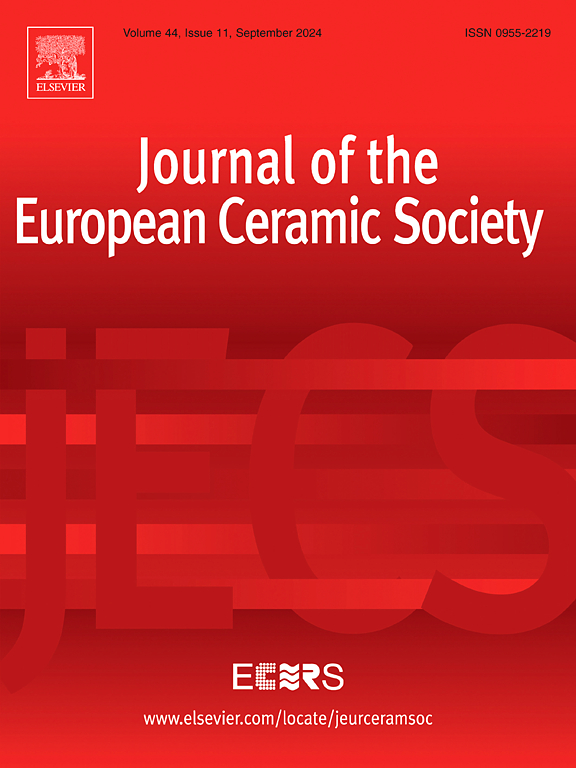Design of a functional steam electrode for Proton-conducting ceramic electrolysis cells based on BaCo0.4Fe0.4Zr0.2O3−δ : BaZr0.7Ce0.2Y0.1O3−δ composite
IF 5.8
2区 材料科学
Q1 MATERIALS SCIENCE, CERAMICS
Journal of The European Ceramic Society
Pub Date : 2025-03-14
DOI:10.1016/j.jeurceramsoc.2025.117348
引用次数: 0
Abstract
A key issue in the steam electrode development for Proton-conducting Ceramic Electrolysis Cells (PCECs) is the required contact with the electrolyte material as well as thermo-chemical compatibility during cell processing and operation. This study focuses on BaCo0.4Fe0.4Zr0.2O (BCFZ442) as a potential steam electrode material paired with the state-of-the-art proton conductor BaZr0.7Ce0.2Y0.1O (BZCY721). The objectives are to identify an optimal material composition amongst several compositional variations and to define its corresponding fabrication conditions for achieving suitable electrodes compatibility, adhesion and performance for further translation into the cell fabrication process. Therefore, we tested 90:10, 70:30 and 50:50 BCFZ442:BZCY721 composites which were heat-treated in the temperature of 800–1200 °C. The phase evolution accompanied by thermal and microstructural analyses and in addition to electrical and mechanical characterization yielded interesting results. Extensive analysis indicate compositional, functional and fabrication optimum in the steam electrode development of PCECs.

基于BaCo0.4Fe0.4Zr0.2O3−δ: BaZr0.7Ce0.2Y0.1O3−δ复合材料的质子传导陶瓷电解电池功能蒸汽电极设计
质子导电陶瓷电解电池(PCECs)蒸汽电极开发的一个关键问题是在电池加工和运行过程中与电解质材料的接触以及热化学相容性。研究了baco0.4 fe0.4 zr0.3 2o3−δ (BCFZ442)与新型质子导体BaZr0.7Ce0.2Y0.1O3−δ (BZCY721)作为潜在的蒸汽电极材料。目标是在几种成分变化中确定最佳的材料成分,并定义其相应的制造条件,以实现合适的电极相容性,附着力和性能,以便进一步转化为电池制造过程。因此,我们测试了在800-1200℃温度下进行热处理的90:10、70:30和50:50的BCFZ442:BZCY721复合材料。相演化伴随着热学和微观结构分析,以及电学和力学特性,产生了有趣的结果。广泛的分析表明,pcec蒸汽电极的组成、功能和制造是最理想的。
本文章由计算机程序翻译,如有差异,请以英文原文为准。
求助全文
约1分钟内获得全文
求助全文
来源期刊

Journal of The European Ceramic Society
工程技术-材料科学:硅酸盐
CiteScore
10.70
自引率
12.30%
发文量
863
审稿时长
35 days
期刊介绍:
The Journal of the European Ceramic Society publishes the results of original research and reviews relating to ceramic materials. Papers of either an experimental or theoretical character will be welcomed on a fully international basis. The emphasis is on novel generic science concerning the relationships between processing, microstructure and properties of polycrystalline ceramics consolidated at high temperature. Papers may relate to any of the conventional categories of ceramic: structural, functional, traditional or composite. The central objective is to sustain a high standard of research quality by means of appropriate reviewing procedures.
 求助内容:
求助内容: 应助结果提醒方式:
应助结果提醒方式:


